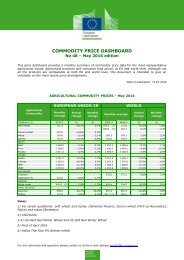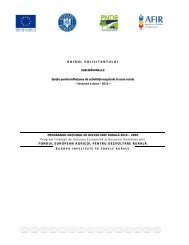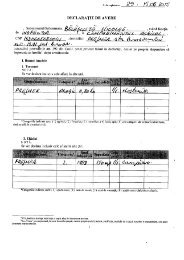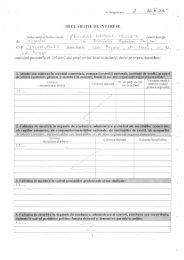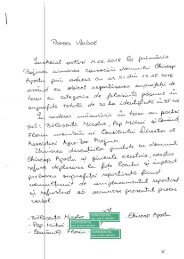You also want an ePaper? Increase the reach of your titles
YUMPU automatically turns print PDFs into web optimized ePapers that Google loves.
2011/01<br />
2011/05<br />
2011/09<br />
2012/01<br />
2012/05<br />
2012/09<br />
2013/01<br />
2013/05<br />
2013/09<br />
2014/01<br />
2014/05<br />
2014/09<br />
2015/01<br />
2015/05<br />
2015/09<br />
<strong>2016</strong>/01<br />
<strong>2016</strong>/05<br />
Short Term Outlook for EU arable crops, dairy and meat markets – Summer <strong>2016</strong><br />
1. MACROECONOMIC OUTLOOK 1<br />
Persist<strong>en</strong>t slowdown in emerging economies<br />
weighs on world economic growth<br />
The World Bank has rec<strong>en</strong>tly (June <strong>2016</strong>) revised its<br />
projection for world growth significantly downwards,<br />
to 2.4% in <strong>2016</strong>, 2.8% in 2017 and a projected 3.0%<br />
for 2018. This prolongs the slowdown of the world<br />
economy, driv<strong>en</strong> by both advanced and emerging<br />
economies. The economic slowdown is not<br />
homog<strong>en</strong>ous in all emerging economies, with<br />
commodity exporting countries hit harder than<br />
expected earlier. Russia, Latin America, Middle East,<br />
North Africa and Sub-Saharan Africa all see their<br />
economic growth projections substantially decreased,<br />
while at the same time the economic growth<br />
projection for South and East Asia, including India and<br />
China remains brighter and unchanged since the<br />
previous edition of the pres<strong>en</strong>t docum<strong>en</strong>t, as well as<br />
for those low income countries with less dep<strong>en</strong>d<strong>en</strong>cy<br />
on commodity exports.<br />
The prospects for EU growth remain nearly<br />
unchanged, with a slow recovery to 1.7% in <strong>2016</strong> and<br />
1.8% in 2017.<br />
Unchanged tr<strong>en</strong>d in terms of exchange rates<br />
Since the low of 1.05 USD per EUR of December 2015,<br />
the euro slightly appreciated towards the USD and<br />
reached 1.15 at the beginning of May, and oscillated<br />
betwe<strong>en</strong> 1.09 and 1.15 USD per EUR since th<strong>en</strong>. Over<br />
the two years, <strong>2016</strong> and 2017, the EUR/USD<br />
exchange rate is expected to remain at 1.11 on<br />
average (around 15% below the average of the three<br />
previous years).<br />
price still remains 52% below the average 2014 level,<br />
with an oversupplied situation and record stocks in a<br />
context of low demand growth. The forecast for <strong>2016</strong><br />
remains betwe<strong>en</strong> 41 and 47 USD/bbl (World Bank,<br />
IHS, IMF), while for 2017 it ranges betwe<strong>en</strong> 50 and<br />
57 USD/bbl. There are few upside risks linked to<br />
possible disruption in some producing countries or<br />
decrease of OPEC production, but they are<br />
counterbalanced by downside risks (continuing lower<br />
growth in emerging economies, slower production<br />
adjustm<strong>en</strong>t of US supply with low prices, developm<strong>en</strong>t<br />
of Iran supply).<br />
Natural gas prices kept on decreasing in the first half<br />
of <strong>2016</strong> and are not expected to pick up in the shortterm<br />
due to large stocks and weak demand both in<br />
Europe and Japan.<br />
Decreasing fertilizer prices<br />
Nitrog<strong>en</strong> (N) fertiliser prices are slowly decreasing<br />
since 2013. Over the five first months of <strong>2016</strong>, urea<br />
average price was 44% below its level in the first<br />
half of 2013 and DAP price (Diammonium phosphate<br />
composed of both N and P nutri<strong>en</strong>ts) was 26%<br />
below, also during the same period.<br />
This price decrease was mainly driv<strong>en</strong> by lower US<br />
natural gas prices (shale gas effect), which led<br />
ev<strong>en</strong>tually to a progressive decrease in the<br />
European Natural gas price starting from late 2013<br />
(by 63% over the same time period) and lower oil<br />
prices since 2014. Gas stock accumulation also<br />
contributed to lower prices.<br />
Graph 1 Crude Oil, natural gas and N fertilisers<br />
prices (index 2007=100)<br />
200<br />
150<br />
Most of the other curr<strong>en</strong>cies depreciated with respect<br />
to the USD, with the exception of some Asian<br />
curr<strong>en</strong>cies and the Swiss Franc. Curr<strong>en</strong>cies of major<br />
high income countries remain as depreciated as the<br />
EUR (or ev<strong>en</strong> more) compared to the USD. Similarly,<br />
curr<strong>en</strong>cies for major commodity exporters such as<br />
Brazil, Arg<strong>en</strong>tina and Russia should stay strongly<br />
depreciated compared to the USD and the EUR.<br />
100<br />
50<br />
0<br />
Oil price expected to remain at low levels in the<br />
coming year<br />
The sharp fall in oil prices until January <strong>2016</strong>, close to<br />
30 USD/bbl, came to an <strong>en</strong>d and prices increased<br />
since th<strong>en</strong> to reach 47 USD/bbl in May <strong>2016</strong>. This<br />
followed several disruptions of supply in Iraq and<br />
Nigeria, as well as the further decrease of US supply<br />
expected in the second half of <strong>2016</strong>. However, the oil<br />
1 Based on IHS (cut-off date 15 th of June <strong>2016</strong>), the European<br />
Economic Forecast Winter <strong>2016</strong> (5 th of May <strong>2016</strong>) and the World Bank<br />
Global Economic Prospects (June <strong>2016</strong>).<br />
Natural gas, US DAP<br />
Natural gas, Europe<br />
Urea<br />
Crude oil<br />
Source: DG Agriculture and Rural Developm<strong>en</strong>t, based on World<br />
bank<br />
Therefore, European natural gas prices finally seem<br />
to b<strong>en</strong>efit from the decrease in <strong>en</strong>ergy prices<br />
reducing the costs of production of N fertilisers. In<br />
addition, lower crop prices and the appreciation of<br />
the USD weigh negatively on the demand for<br />
fertilisers, and the decrease in N fertiliser prices<br />
should last throughout 2017, despite the recovery in<br />
crude oil price.<br />
2



